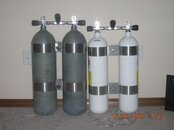I'm curious about your thinking regarding redundancy.
If you use twin 45cuft tanks and breath one down to 500psi you wind up with about 8.5cuft in reserve. With twin 40cuft tanks about 6cuft. This takes into account a loss of gas on the cylinder you are breathing after the switch.
Seems like a lot of trouble and expense to (in effect) carry a spare air.
Not trying to be negative but is all the trouble worth it for so little reserve gas (and the false sense of security it will give you) in a situation where you don't really need redundancy anyways? Twin the small tanks if that's what you want (variety is the spice of life) but practically speaking you would be better off doing proper gas planning using a single tank and being well versed in CESA's from that depth. If you try to do deeper dives with that rig as you say by slinging a pony/stage you will have a real problem keeping on top of the rapid depletion of gas. Twin small bottles will be more of a hazard than anything and you will also need 3 sets of regs to do the job of two.
With regards to the upsidedown valves. If you are diving independant twins you really have no need to manipulate the valves during the dive. That's the benefit to that set up.
Again, not knocking your ideas outright, just offering a counterpoint to consider.
Well i'm kinda shopping for ideas at this point.
But i do think dual tanks are safer. If i dive solo in 50Ft, on a steel 80 and i get a bad free flow or total loss of air, nothing i can really do at that point but swim the rig on a breath hold. With the twins i can just turn off the free flow tank and abort the dive safe on air. Now how to route this kit i'm still stuck on. independents vs manifold....
Prob. leaning towards independents right now. If i can run dual tanks independent,
that will give me dual regs. I also would like to find a company/person that would be willing to help me build a dual bladder wing in the 20-25 lb range. Im also researching ways to be able to cut flow to the inflator in case of a free flow failure, and still be able to use the air out of that tank to surface.
So with a light weight rig like this, i can if possiable, isolate an entire side of the system if there is a problem. and have enough air to surface safe. Even if a problem happens with one tank at 500psi, and the other at 500psi, that gives me plenty of air to surface safe and controlled. If im diving deeper then say 60 or so feet with a buddy,
i would just carry a sling 13 tank or so.....
I feel without doubt im technical enough in nature to dive this rig safe. I have enough
since i feel to watch the gauges, and switch over when needed, on time ect ect.
So thats kinda were im at now. But learning more every miniute, and this all could change soon.







